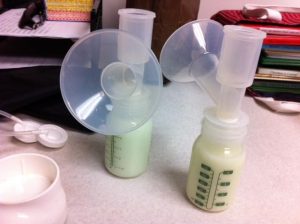Table of Contents
Introduction
Many breastfeeding moms want to stock up on breastmilk by pumping the excess that they have. They want to make sure that there is breastmilk available for others to feed their babies when they aren’t available. For instance, these moms will eventually have to go back to work after maternity leave. Therefore, a caregiver will need to feed her baby at that time.
Breastfeeding moms may also decide to donate their extra breastmilk and send it over to milk banks. Therefore frozen milk is necessary for milk banks. However, when the time comes for thawing the frozen breastmilk, there are methods to make sure it happens successfully. Let’s go over how to thaw breastmilk effectively and safely.
How To Thaw Frozen Breastmilk Quickly
If you want to know how to unfreeze frozen breastmilk fast, you want to ensure you thaw it by abiding by the safety guidelines. The last thing you want to do is cause the breastmilk to lose nutrients and spoil during the thawing process. The rule of thumb is to thaw the bag of milk with the oldest date first.
One way to defrost frozen breastmilk is to place it inside a bowl of lukewarm water. You do not want the water hot, so make sure the water is lukewarm. You can also hold the bag of breastmilk under a running tap of lukewarm water. It is not advisable to allow the milk to thaw at room temperature.
Never place the frozen breastmilk in the microwave or inside of a pot of boiling water. You may wonder how breastmilk heating would be problematic since you can allow it to cool down. However, if you heat the milk, it will kill the nutrients.
After thawing the breastmilk, you can leave it at room temperature for up to four hours. You can also put the milk in the fridge for no longer than 24 hours.
Alternatively, you can also thaw the milk in the refrigerator if you want to do so overnight, which many moms prefer to do. Let’s talk about how to do that effectively.
How To Thaw The Frozen Breastmilk In The Refrigerator
Bear in mind; it takes 12 hours to thaw breastmilk in the refrigerator. That is why you will want to place the milk in the fridge to defrost the night before. Putting the milk to unfreeze in the fridge is quick, and there is no need to stand around under a running tap of warm water or wait for it to thaw in a bowl of warm water. That is why plenty of moms opt for the option of thawing milk in the fridge.
Since it takes 12 hours for the milk to thaw in the refrigerator, you need to time it based on when your baby has their first feeding in the morning. For instance, if your baby has their first feeding at 7 am, you will want to put the frozen breastmilk in the fridge between 6:30 to 7 pm. It is okay if it stays in the refrigerator longer, as you can keep thawed breastmilk in there for 24 hours. It just makes it easier if you time it based on when your baby has their morning feeding.
Remember that the milk must get to room temperature after being in the fridge for so long by running it under warm water. Just be sure to squirt the milk on your wrist, so you know when it reaches room temperature for your baby to drink.
If you prefer to thaw the milk in warm water, whether in a bowl or a running tap, let’s talk more about how you can do that.
How To Properly Thaw Frozen Breastmilk In Warm Water
If you did not have a chance to put the frozen breastmilk to thaw in the fridge the night before, you could defrost it quickly by placing it in a bowl of lukewarm water. All you need to do is to take a bowl and fill it up with lukewarm water. Ensure that the water level does not exceed the breastmilk bag’s cap so that it does not contaminate it.
Test the water continuously as the water will get cold. Once it does, replace the cold water with lukewarm water and keep doing this until the milk completely unfreezes. This process takes about 20 minutes, and after completion, you can immediately feed your baby and place the extra milk in the fridge to use during the day.
You can also thaw the milk under running lukewarm water. The thing to do is to hold the bag under cold water to start. Then slowly turn the tap into the lukewarm setting and allow the water to run over the bag until the defrosting finishes.
Conclusion
Breastfeeding moms want to create a stockpile of bags of breastmilk to freeze for various reasons. When the time comes to thaw the milk, the defrosting must happen in ways where the milk won’t spoil or lose its nutrients. The one thing to remember is that the breastmilk will smell soapy or metallic after it is thawed based on chemical reactions.
The milk is safe and won’t bother the baby. Therefore, that is normal. However, the one thing to always remember is that after thawing milk, do not freeze it again if there is an excess of defrosted milk. If there is an excess of defrosted milk that will last longer than a day, toss out the extra milk.

